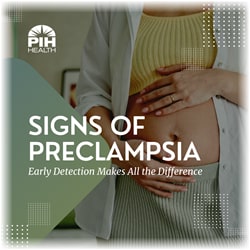Signs of Preeclampsia: Early Detection Makes All the Difference
 Preeclampsia is a serious medical condition that can occur after 20 weeks of pregnancy. It is a condition characterized by high blood pressure and protein in the urine. If left untreated, preeclampsia can lead to serious—even fatal—complications for both mother and baby. Routine prenatal visits are key to catching preeclampsia before it worsens.
Preeclampsia is a serious medical condition that can occur after 20 weeks of pregnancy. It is a condition characterized by high blood pressure and protein in the urine. If left untreated, preeclampsia can lead to serious—even fatal—complications for both mother and baby. Routine prenatal visits are key to catching preeclampsia before it worsens.
According to the Centers for Disease Control and Prevention (CDC), preeclampsia affects about 4% of pregnancies in the United States. Although the exact cause of preeclampsia is unknown, it is more common in:
- first time pregnancies
- women who are older than age 40
- women carrying more than one baby
- women with a history of diabetes, high blood pressure, kidney problems, lupus or rheumatoid arthritis or a personal or family history of preeclampsia
What are signs of preeclampsia?
Many people with preeclampsia have no noticeable symptoms. Often the first signs of preeclampsia are detected during routine prenatal visits with a health care provider.
There are three main symptoms of preeclampsia:
- High blood pressure: A blood pressure reading that exceeds 140/90 mmHg in an expectant mom who has no history of high blood pressure is usually the first sign of preeclampsia.
- Excess protein in the urine: Any amount of protein in the urine over 300 mg in one day may be a sign of damage to kidneys and other organs, indicating preeclampsia.
- Sudden weight gain or abnormal swelling: Although swelling can be normal in pregnancy, swelling in the face and hands and sudden weight gain (three to five pounds or more in a week) sometimes precedes signs of preeclampsia.
Other signs of preeclampsia include:
- Abdominal pain on the upper right side
- Decreased urination
- Nausea or vomiting
- Severe headaches
- Vision changes, including sensitivity to light, blurred vision, floaters or temporary vision loss
“Preeclampsia is a serious condition that you may not be aware you even have. It's essential to go to all your prenatal appointments and share all your pregnancy symptoms with your doctor,” says Allison Hill MD, an OB/Gyn at PIH Health Women’s Center-Wilshire. “When preeclampsia is caught early, it can be treated and managed to keep both you and your baby safe and healthy.”
How is preeclampsia treated?
Preeclampsia can only be cured by delivering the baby. However, treatment will depend on how severe the preeclampsia is, the health of the unborn baby and how far along in pregnancy.
- When preeclampsia is detected earlier in pregnancy: Close monitoring of mother and baby is done in an effort to prolong the pregnancy, allowing baby more time to grow and develop. More prenatal appointments may be needed, including ultrasounds, non-stress tests, urine tests and blood draws. At home or hospital monitoring of blood pressure, and medication to control high blood pressure may be prescribed.
- At 37 weeks pregnant: The baby likely will be developed enough to be safely delivered, and inducing labor or performing a cesarean section (C-Section) to prevent preeclampsia from progressing may be recommended.
- If preeclampsia worsens or becomes more severe: The doctor may need to deliver the baby immediately. During labor and following delivery, magnesium is often given intravenously to prevent the development of eclampsia (seizures from preeclampsia).
- If preeclampsia is left untreated: Common complications may include preterm birth, low birth weight or placental abruption (separation of the placenta from the uterus). Preeclampsia can also cause HELLP syndrome (Hemolysis, Elevated Liver enzymes and Low Platelet count), when preeclampsia damages mother’s liver and red blood cells and interferes with blood clotting. This is life-threatening to the mother and baby, and may cause lifelong health problems for the mother.
“During pregnancy, it’s important to keep you and your baby as healthy as possible. This includes eating a balanced diet, taking prenatal vitamins, and going for regular prenatal care checkups,” says Dr. Hill. “Keeping up with your prenatal visits, knowing the warning signs, and letting your doctor know about any symptoms can help prevent serious complications for you and your baby.”
Talk to your doctor if you are pregnant and think you might be at risk for preeclampsia or are experiencing symptoms. Whether you have symptoms or not, attending all your prenatal visits can make all the difference. Visit PIHHealth.org/Women to learn about our Women’s Health program.

SCHEDULE AN APPOINTMENT
Make or request an appointment online with an OB/GYN today.
Book Now